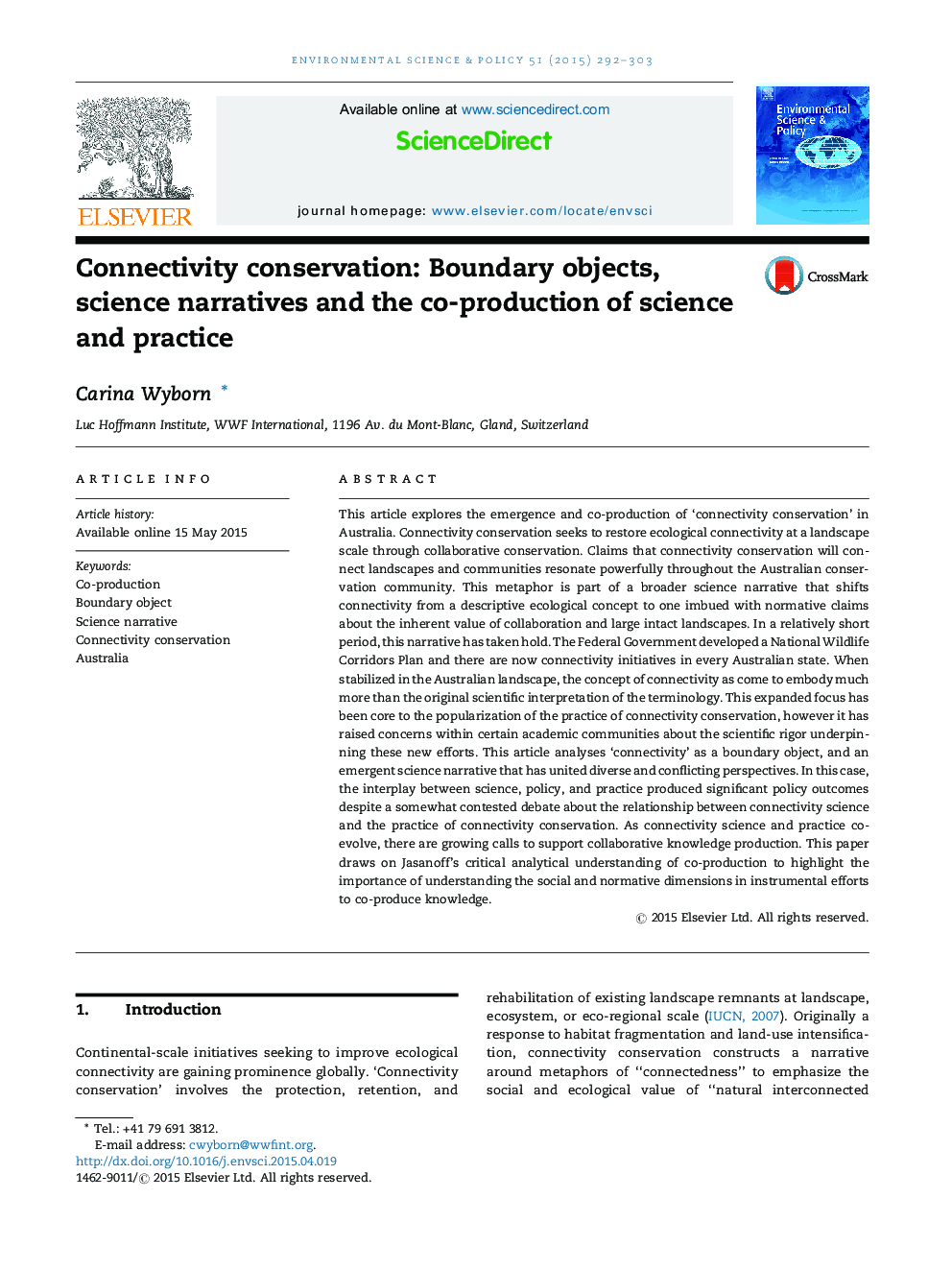| کد مقاله | کد نشریه | سال انتشار | مقاله انگلیسی | نسخه تمام متن |
|---|---|---|---|---|
| 7467450 | 1485055 | 2015 | 12 صفحه PDF | دانلود رایگان |
عنوان انگلیسی مقاله ISI
Connectivity conservation: Boundary objects, science narratives and the co-production of science and practice
ترجمه فارسی عنوان
حفاظت اتصال: اشیای مرزی، روایات علمی و همکاری تولید علم و عمل
دانلود مقاله + سفارش ترجمه
دانلود مقاله ISI انگلیسی
رایگان برای ایرانیان
کلمات کلیدی
همکاری تولید، جسم مرزی، روایت علمی، حفاظت اتصال استرالیا،
ترجمه چکیده
این مقاله به بررسی ظهور و همکاری تولید حفاظت اتصال در استرالیا می پردازد. حفاظت از اتصال به دنبال بازسازی محیط زیست در مقیاس منظر از طریق حفاظت از همکاری است. ادعا می کند که حفاظت از ارتباطات چشم اندازها و جوامع را تقویت می کند در سراسر جامعه حفاظت از استرالیا قدرتمند است. این استعاره بخشی از یک روایت علمی وسیع است که ارتباط را از یک مفهوم اکولوژیکی توصیفی به یکی از ادعاهای هنجاری در مورد ارزش ذاتی همکاری و مناظر بزرگ باقی می گذارد. در یک دوره نسبتا کوتاه این روایت گرفته شده است. دولت فدرال یک طرح ملی راه حلی حیات وحش را ایجاد کرد و اکنون در هر کشور استرالیا در حال پیاده سازی است. هنگامی که در منظر استرالیا تثبیت شد، مفهوم اتصال به عنوان مفهوم بسیار بیشتر از تفسیر علمی علمی اصطلاحات است. این تمرکز گسترش یافته، بخش عمده ای از محبوبیت حفاظت از ارتباطات بوده است، اما در برخی جوامع خاص دانشگاهی، نگرانی های جدی علمی بر پایه این تلاش های جدید ایجاد شده است. این مقاله، «اتصال» را به عنوان یک شیء مرزی و یک روایت علمی جدید که رویکردهای متفاوتی و متضاد را متحد کرده است، تحلیل می کند. در این مورد، اثر متقابل بین علم، سیاست و عمل، نتایج علمی قابل توجهی را بدست آورد، باوجود بحث در مورد بحث ارتباطی بین علم ارتباطات و حفاظت از ارتباطات. به عنوان ارتباط علم و عمل همکاری می کنند، تماس های در حال رشد برای حمایت از دانش تولید مشترک فراهم شده است. این مقاله بر روی درک تحلیلی انتقادی جاسانوف از تولید همکاری تأکید می کند تا اهمیت درک ابعاد اجتماعی و هنجاری در تلاش های سازنده برای تولید دانش را برجسته سازد.
موضوعات مرتبط
مهندسی و علوم پایه
مهندسی انرژی
انرژی های تجدید پذیر، توسعه پایدار و محیط زیست
چکیده انگلیسی
This article explores the emergence and co-production of 'connectivity conservation' in Australia. Connectivity conservation seeks to restore ecological connectivity at a landscape scale through collaborative conservation. Claims that connectivity conservation will connect landscapes and communities resonate powerfully throughout the Australian conservation community. This metaphor is part of a broader science narrative that shifts connectivity from a descriptive ecological concept to one imbued with normative claims about the inherent value of collaboration and large intact landscapes. In a relatively short period, this narrative has taken hold. The Federal Government developed a National Wildlife Corridors Plan and there are now connectivity initiatives in every Australian state. When stabilized in the Australian landscape, the concept of connectivity as come to embody much more than the original scientific interpretation of the terminology. This expanded focus has been core to the popularization of the practice of connectivity conservation, however it has raised concerns within certain academic communities about the scientific rigor underpinning these new efforts. This article analyses 'connectivity' as a boundary object, and an emergent science narrative that has united diverse and conflicting perspectives. In this case, the interplay between science, policy, and practice produced significant policy outcomes despite a somewhat contested debate about the relationship between connectivity science and the practice of connectivity conservation. As connectivity science and practice co-evolve, there are growing calls to support collaborative knowledge production. This paper draws on Jasanoff's critical analytical understanding of co-production to highlight the importance of understanding the social and normative dimensions in instrumental efforts to co-produce knowledge.
ناشر
Database: Elsevier - ScienceDirect (ساینس دایرکت)
Journal: Environmental Science & Policy - Volume 51, August 2015, Pages 292-303
Journal: Environmental Science & Policy - Volume 51, August 2015, Pages 292-303
نویسندگان
Carina Wyborn,
